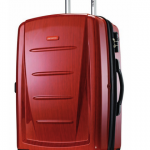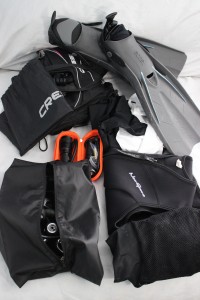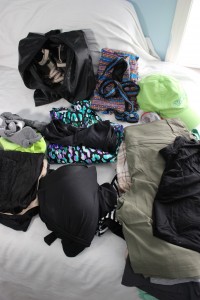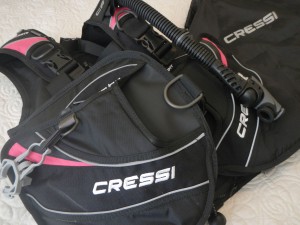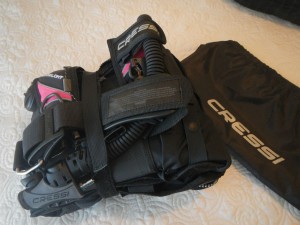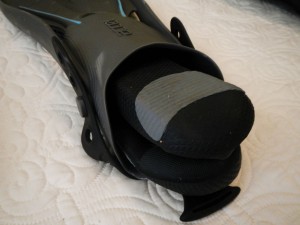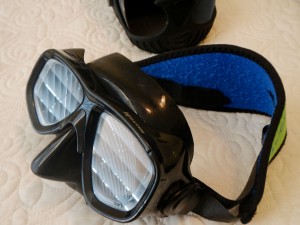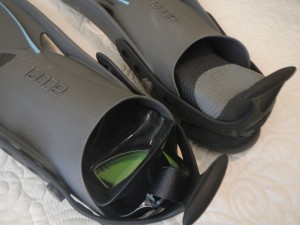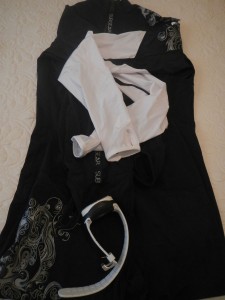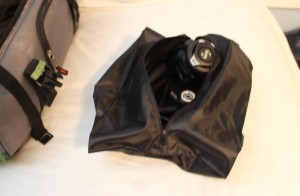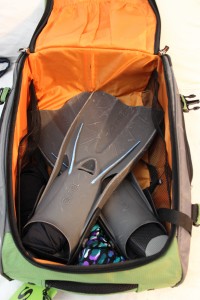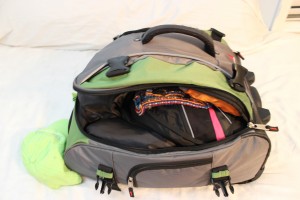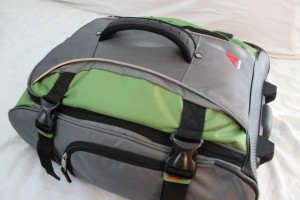Scuba divers need to pack not only swimsuits, clothing, and toiletries for a trip, but also heavy and expensive dive equipment. Because you don’t your dive gear to be lost, stolen, or damaged, it’s important to get as much equipment into your carry-on luggage as possible. A good rule of thumb for choosing in which bag to place an item is whether you can get along without it (by possibly purchasing or renting the item) at your destination.
Download the Packing List
Download the editable Microsoft Word document or the single-page PDF to keep this dive trip packing checklist handy.
| Editable Page | One-Page Checklist |
|---|---|
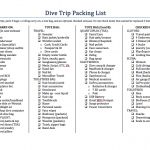 |
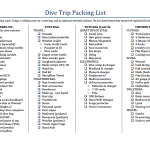 |
| DiveTripPackingList.docx | DiveTripPackingList.pdf |
Choosing Your Bags
To travel efficiently, it is important to have the right bags. You want to minimize bag weight and maximize interior space. You also need a durable bag – especially the wheels!
Dive Bags
We do not recommend that you purchase a heavy-duty dive bag. If you have an expensive equipment bag checked in with an airline, it indicates to thieves in airport security or customs that there might just be thousands of dollars in gear in the bag.
It is, however, worthwhile to pack a mesh gear bag. Sometimes, dive resorts keep and move your gear for you. But even if you only need to carry your gear down to the dive shop, it’s nice to have a mesh bag. You will especially appreciate it when you have to lug and rinse your own gear.
Carry On Bag
This is the bag or suitcase that needs to fit in the overhead bin on the plane. It’s important to get a square bag of near the maximum allowed dimensions so you have the most space for packing. Travel Nerd has a great chart with details per airlines, but a 22″ x 14″ x 9″ carry on currently works for all airlines.
Personal Bag
Most airlines allow you to carry a personal item, such as a purse, tote bag, or laptop bag, as long as it fits under the seat in front of you. Typically, that is 20″ x 17″. If you’re looking for a new bag, EBags has a great tool to search by size – under seat. Most of those bags are rounded and wheeled. And don’t forget, if you fill up the space under your seat completely, you won’t have room to stretch out your feet.
Checked Suitcase
Airlines have some restrictions on size, but the most important limitation you will encounter is the 50 lb weight limit. When you think about your checked bag, think that when it is out of your sight, someone could throw it, drag it, and basically destroy it. It needs to take a beating and protect your stuff. You also need to consider that when it’s not in your possession, unscrupulous people could go through your stuff and even steal things from your bag. An ugly, beat-up bag is less likely to contain expensive stuff, and it’s less likely to be robbed.
You do need to do something to make sure that you can easily spot your bag. Buy an orange bag. Put neon zipties on the handles.
Packing Your Bags
The key to being able to pack everything you need in your bags is how you pack.
Carry-On Bag
How you pack your bag is important.
Step 1 – Gather your carry-on items
Gather all of the items that you will be packing in your carry-on:
Roll your travel BCD as tight as you can:
Stuff both boots into one fin to save space:
Flip the mask strap around to protect the mask glass and put it inside your other fin, then roll your scuba socks and headband inside the glass:
Roll your dive computer inside your dive skin (or shorty/wetsuit):
Roll up your outfits and put your clothes and regulator set into waterproof nylon shoe bags:
Step 2: Pack larger items first with smaller items around them used as filler
Put your fins in your carry on first. If you place your rolled swimsuits under the top fin, you save the wasted space:
Align your camera pole along a fin so that it doesn’t get bent or broken, and add your bagged clothes and scuba gear around the edges of the bag:
Then add your undies and dive bag to the pouches in the lid of the bag, and lay your regs and other thin items on top of your gear:
This packing method means that when you stand your rolling bag, your heaviest item is in the bottom, which will keep it from tipping over in the airport. It also protects your regs by having them in the center of the bag.
Compress everything and carefully zip your bag:
It’s stuffed. You will not have room to slip in extra items and you will have to pack just as carefully when you come home. Do not try to use the outside pockets, because it will make the bag oversized and you might be forced to check it.
Personal Bag
Try to put the heaviest items in your carry-on so that you can roll the heavy stuff. Everything else needs to go into your personal (tote) bag. Make sure that you can get to your laptop and TSA bag quickly when you go through security.
Step 3: Put everything else in your tote bag
The great thing about a big, open bag is that you can fit a lot of stuff. To contain stuff, use smaller bags, like the freebie makeup bags:
Checked Suitcase
Pack your suitcase like you packed your carry-on bag. Put the heaviest items in the bottom so it will roll easily. Put breakable items in the middle and pack clothes around them. Put all of your big containers of liquid, such as sunscreen and aloe vera, into a ziplog bag and in a waterproof shoe bag.





